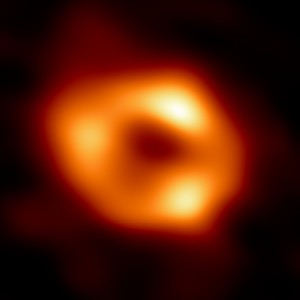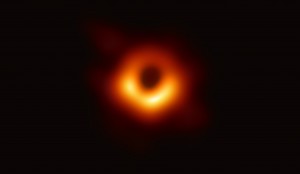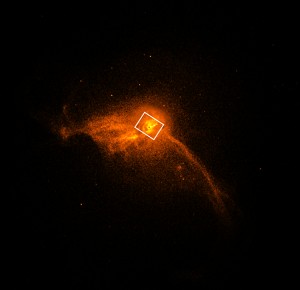Sagittarius A*: A Star (figuratively) of the Milky Way Gets Its Close-up
Monday, June 6th, 2022
The first image of Sagittarius A*, the supermassive black hole at the center of our galaxy.
Credit: © EHT Collaboration
Finally, the faceless monster lurking at the center of our galaxy has been photographed. Sounds like science fiction? It’s true! On Thursday, May 12, scientists with the Event Horizon Telescope (EHT) team published a photograph of Sagittarius A* (saj uh TAIR eeuhs AY star). Sagittarius A* is a supermassive (huge) black hole in the center of our galaxy, the Milky Way.
A black hole is a region of space whose gravitational force is so strong that nothing can escape from it, not even light. The event horizon is the “point of no return” for a black hole: Anything that crosses this horizon is sucked into the black hole forever. Supermassive black holes at least a million times more massive than the sun lurk at the center of many galaxies.
The EHT is a global network of ground-based telescopes that use a technique called radio interferometry to produce images of black hole event horizons. The collection of radio telescopes participating in the EHT project stretches from Hawaii to Europe and all the way south to Antarctica. Several dozen of the world’s leading observatories and universities contribute to the project. Supercomputers process the image data using special algorithms in a process called correlation.
Astronomers began using the EHT to make observations of Sagittarius A* in 2017. In 2019, the EHT released an image it had captured of the event horizon surrounding the supermassive black hole at the center of the Messier 87 galaxy (M87*). It was the first time an event horizon had been photographed.
If light can’t escape a black hole, how did EHT photograph M87* or Sagittarius A*? Technically, it didn’t: all black holes are invisible and cannot be directly photographed. But matter trapped in orbit near the event horizon is extremely energized and emits large amounts of light. The black hole lurks in the circular “shadow” within the halo of high-energy matter. Thus, the EHT can take a picture of a black hole much as we can take a picture of a doughnut hole.
Despite being closer to Earth, Sagittarius A* was still harder to image than M87*. Sagittarius A* is still 27,000 light-years from Earth. It’s also more than 1,000 times smaller and less massive than M87*. So, although the high-energy matter is orbiting both black holes at about the same speed, the matter completes an orbit around Sagittarius A* in a matter of minutes. Furthermore, Sagittarius A* is “quieter”: it emits far less energy than M87*. All these factors made it difficult for EHT to capture an image of it.
Now that EHT has imaged two black holes, astronomers can compare them. Both look remarkably similar, despite their differing sizes. Both confirm what was predicted by Einstein’s theory of relativity. But plenty of questions remain. For example, are the “blobs” in the picture actual elements, or are they artifact of the correlating process? The EHT is also considering the feasibility of creating a short video of Sagittarius A* by stringing together multiple consecutive images. And plenty more supermassive black holes are waiting for their photographic debut. A major observation campaign that concluded earlier this year featured even more telescopes. Expect more exciting results soon regarding these most extreme objects in the universe.




